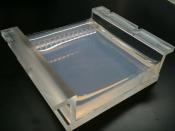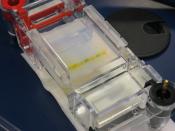Agarose gels electrophoresis is used to separate DNA fragments that have been digested by restriction endonucleases. Restriction endonucleases are enzymes that cut double-stranded DNA into smaller fragments. These fragments are placed in agarose gel and an electric field is applied across it. The negatively charged DNA moves toward the positive end of the field. The smaller fragments move faster than the larger fragments, thus the fragments separate.
This experiment was an introduction to agarose gel electrophoresis. However, various colored dyes were substituted for the DNA samples. Unlike DNA, dyes can be positively or negatively charged. Therefore dyes will move to their corresponding negative and positive ends, respectively. Each dye will migrate at different rates much like the different DNA fragments. We tested five individual dyes and observed their migration rate. We also tested 3 unknown dyes and determined their compositions.
We first prepared the gel-casting tray by sealing the ends with tape and inserting the well-forming comb into the middle set of grooves on the tray.
The comb then laid over the red tape. Agarose gel was then poured into the tray to cover only about 1/3rd the height of the comb teeth. The gel was then allowed to solidify which took about 10 min. After the gel solidified, the tape was removed from the ends of the tray, and the tray was placed into the gel box with the black tape and red tape at the negative and positive ends, respectively. Tris-borate-EDTA, the buffer solution that was used, was then poured into the gel box to a level that just covered the entire surface of the gel. The well-forming comb was then removed gently in order not to rip the wells. Next, 10 to 20 ml of each of the dye samples were loaded using a transfer pipette in...


